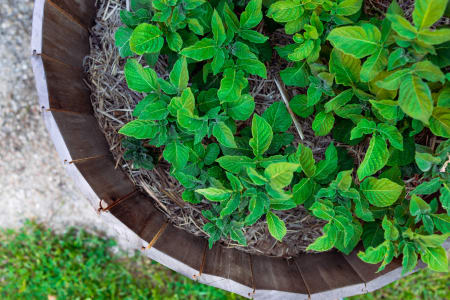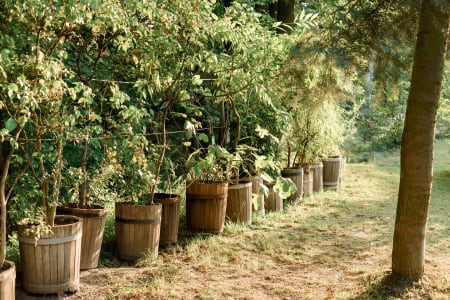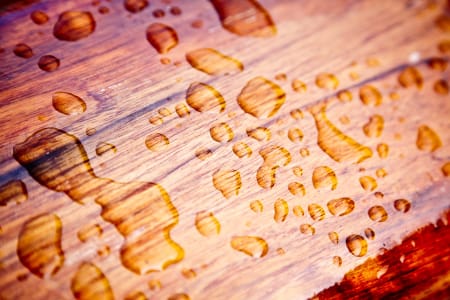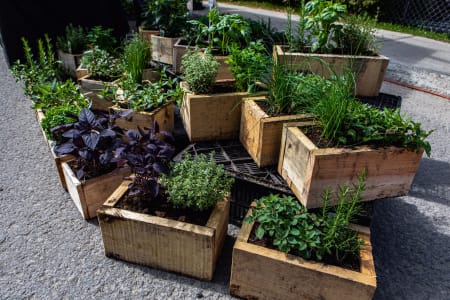Is Polyurethane Or Deck Sealer Better For Garden Boxes
The Safest Products to Protect Your Raised Garden Bed
Without the toxic chemicals
Now is the time to prepare your wooden raised bed or container garden for the growing season and beyond! This article is about how to protect your structure so it not only looks good but holds up for many years—and doesn't harm you or your soil in the process.

How do you permanently protect your structure so that:
- moisture inside the soil won't rot your wood?
- chemicals in or on the wood won't leach back into your soil?
- harmful UV rays of the sun won't wear out the finish?
- mold and mildew won't contaminate your soil?
- critters won't eat through everything?
- you won't have to re-finish this all over again next year?
While we don't have one solution to fit all these problems, we've discovered several products that handle most of them. These products are called foundation sealers for the inside and weather resisting stains and sealers for the outside.
Most people don't realize that the sealers required to protect the outside are different from the inside. That's because the inside of your garden bed is full of soil and moisture that sits against your wooden frame 24/7. Soil contains acids, bugs, and moisture that can rot your wood and destroy it over time. Also, most coniferous wood species contain tannins that can leach into the soil. If your wood has been recycled or salvaged, it may have been previously sealed with toxic sealers that can also react with the soil. Only foundation sealers can hold up to this type of exposure.
The outside of the bed has different exposures, mainly to the sun, rain, wind, snow, etc. that are temporary and will weather away the surface over time. Using a clear wood sealer will protect against moisture but not against the sun and will therefore grey out in one to two years. We recommend an exterior wood stain and sealer all in one because the pigments in the stains block UV rays and withstand various types of weather much better.

Sealing the Inside of your Raised Bed
AFM Safecoat Dynoseal
Dynoseal forms a permanent, non-toxic, thick flexible membrane that is waterproof and vapor-proof. It was designed for below-grade (below ground) foundation walls and fence posts but can also be used to repair roofing, metal seams, shower stalls, tubs, and saunas—just in case you wanted to know. It is highly resistant to temperature change, gasoline, oil, grease, fungi, acids, and alkalies.
What's great about Dynoseal is that it will bond and coat just about any surface that is clean and dry, old or new, including all soft and hardwoods and pressure-treated wood. It can also be used on the insides of planters made of metal, concrete, and ceramic and will prevent rust, efflorescence, and cracking from freeze-thaw. It is a perfect fit for safely sealing the insides of almost any type of raised garden bed.
Dynoseal's life expectancy is 20 years if applied properly. One gallon covers about 100 SF in two heavy coats with a 3/8" nap roller. It only comes in black color. For complete installation information read here

Sealing the Outside of your Raised Bed
Typical exterior wood stains and sealers are easy to find, however, most contain high levels of VOC, solvents and require repeated application. We've found some excellent alternatives that won't off-gas hazardous air pollutants and will look beautiful for a long time.
These are available either as a water-based stain and sealer or an oil-based stain and sealer. Both types are non-toxic and designed for soft and hardwood with the exception of oily exotic woods like Teak, Ipe, or Mahogany. They will also work well over pressure treated wood, if and only if, the wood has seasoned outdoors for a year prior to application. Which is the best? Please keep reading.

Water-based Finishes—by Vermont Natural Coatings (VNC):
PolyWhey Exterior Penetrating Stain (14 colors) This is our most popular product because it emits ultra-low VOC and virtually no odor when dry in a few hours. It's a stain and waterproofing sealer all in one.
The colored pigments in the PolyWhey Exterior Stain provide the best long-lasting protection against the UV rays of the sun. The natural polywhey protein from milk provides a waterproof barrier that not only inhibits moisture, but mold, mildew, and decay as well. Life expectancy with full exposure to the sun on the South or West side: three to four years; five to six years for Northern exposures. Not for use below grade.
Coverage: 1 gallon yields 200-400 SF/gallon in two coats, depending on the porosity and species of the wood. Freshly sanded wood and soft woods tend to absorb more and yield less coverage.
For complete installation information read here.
Clear Penetrating Water Proofer Infused with Juniper
Natural Juniper offers superb resistance to moisture, mold, mildew, and decay but will grey in one to two years. It's a clear penetrating sealer for those who want to enjoy the visuals of their beautiful wood and don't mind reapplication in a few years.
VNC Water Proofer is non-toxic and zero VOC with virtually no odor when wet and dries in a few hours. This penetrates into the grain of the wood and leaves no coating on the surface leaving you with a raw wood look. It dries clear and will not yellow.
Life expectancy with full exposure on the South or West side: two years. Add another two years for Northern exposures. Not for use below grade.
Coverage: 1 gallon yields 300 SF in two coats. Applications over soft woods will yield less coverage.
For complete installation information read here.
Oil-based Finish—by Rubio Monocoat
Hybrid Exterior Wood Protector (21 colors)
Rubio Monocoat Hybrid is an oil-based stain and sealer all in one. It is non-toxic, zero VOC, and comes in 21 semi-transparent colors that blend well with most older stains. It is easy to apply and fast drying. It's not film forming and will not flake off. It contains no petroleum solvents or other hazardous ingredients. There is a slight linseed odor when wet and virtually no odor when fully cured in 7-14 days.
Unlike most water-based stains and sealers, Rubio's Hybrid oil works well over previously sealed water-based or oil-based finishes. The colored pigments provide long-lasting protection against the UV rays of the sun as well as moisture, mold, mildew, and rot. (Note: the Clear/Pure color has no UV protection and will not provide color stability against the natural aging of the wood.)
Rubio Hybrid is more expensive than our water-based products but these are not overpriced for what you get. Life expectancy with full exposure on the South or West side: three to four years, and five to six years for Northern exposures. Not for use below grade.
Coverage: 1 liter yields 121-222 SF in two coats depending upon the porosity of the wood. Again, softer woods are more porous and yield less spread.
For complete installation information read here.
What About A Paint Option?
A question we get asked all the time is : What if my raised bed has already been painted and is peeling or the wood has other finishes already on it?
Start by sanding off any rough areas or peeling paint and then cover with our exterior AFM SafeCoat Transitional Primer followed by All Purpose Exterior Satin Custom Color Paint. Priming and painting with this non-toxic, low VOC paint will yield the best protection against UV rays and other natural elements. Do not use any penetrating water or oil-based stain and sealer over a painted surface.

Samples of all of the above sealers are available on our website. We highly recommend testing first to determine what looks best, adheres properly, and is most tolerable to you. Call our eco-advisors if you have additional questions. 800.405.0222
www.greenbuildingsupply.com
©2021 Joel Hirshberg
Is Polyurethane Or Deck Sealer Better For Garden Boxes
Source: https://www.greenbuildingsupply.com/Learning-Center/Featured-LC/The-Safest-Products-to-Protect-Your-Raised-Garden-Bed
Posted by: motleychricand.blogspot.com

0 Response to "Is Polyurethane Or Deck Sealer Better For Garden Boxes"
Post a Comment